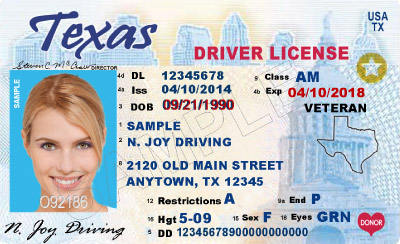- 0 Incorrect (12 allowed to pass)
- 0 Correct
- Updated for February 2025
- Based on official Texas Driver's manual
Free DMV Written Test Simulator for Texas | Updated for 2025
If you live in Texas, you already know it’s big, with an area of 268,596 square miles. If Texas were a country, it would be the 40th largest country on earth, larger than any European country. The state operates the largest highway and rail networks in the country. But to use all those highways to get around the state on your own, you’ll need to obtain a Texas driver’s license.
In Texas, if you’re under 18, you must obtain an instruction permit (learner license) before applying for a driver’s license. The permit will allow you to practice driving under supervision. To obtain a permit in Texas, you must meet a whole series of requirements. One of the most crucial requirements is to pass a written knowledge exam on driving theory. (However, this exam may be waived if you’ve completed an approved driver education course.)
If you’re 18 or older, you must also pass the knowledge exam, but you won’t apply for a permit. Instead, you’ll apply directly for a driver’s license. However, the license will initially have the same restrictions as the instructional permit (learner license) issued to teen drivers.
The Texas DMV written test has 30 multiple-choice questions based on the official driver’s manual (Texas DMV Handbook (TX Driver's Manual) 2025). The passing score is 70%.
This is our second of five Texas Permit Practice Tests. All our permit practice tests have been designed to help aspiring drivers like you pass the DMV knowledge test on their first try. These practice tests are up to date as of February {current year} and also based on the official Texas driver’s manual. All 40 questions on this practice test are multiple choice. You must choose the best or most complete answer for each question.
Feel free to ask our AI Assistant for help if you get stuck on a question. You can ask it to give you a hint or discuss the question in more depth. If you still miss the question, the AI Assistant will provide you with the correct answer and an explanation. Watch the Progress Bar to keep track of your score. Each question you answer correctly will turn green, and each question you get wrong will turn red.
We also have our own Texas DMV Permit Test Study Guide, which we recommend you download and read as the written knowledge exam day approaches. It will give you useful tips to help you avoid any unpleasant surprises. It covers what documents to take with you to the test, fees you may have to pay, how to stay relaxed yet alert for the test, and frequently missed test questions.
- Perfect for learner’s permit, driver’s license, and Senior Refresher Test
- Triple-checked for accuracy
What you need to know

What to expect on the actual TX DMV exam
questions
correct answers to pass
passing score
minimum age to apply
List of questions (classic view)
- Before changing lanes, you should
- If you're having vehicle trouble at night and need to stop, you should use _________ to avoid an accident.
- What is the correct hand and arm signal for indicating a right turn?
- Which of the following statements about parking is FALSE?
- To enter a freeway smoothly, enter an acceleration lane and _________ to match the speed of highway traffic.
- Headrests should be adjusted so that the head restraint contacts the back of the head. This prevents
- You must maintain a constant speed when passing and reentering the lane in front of a truck or bus, because trucks and buses require
- If you are parallel parked on the right side of the street, you should _________ before pulling out into traffic.
- Blind pedestrians may carry _________ canes or use the assistance of guide dogs.
- When you park and leave your vehicle in the street, you should NOT
- To enter a main road from a driveway, an alley, or the roadside, you must
- Which of the following can be considered a legal parking zone?
- On a multilane freeway, pedestrians should walk
- When you drive through a work zone, you should NOT
- To enter an expressway or freeway, you must _________ before merging with the traffic.
- When entering or exiting a roundabout, you must
- At an intersection that is not controlled by signs or signals, you must yield to
- If you see a flag person on the road, it means that
- On a two-way road, a _________ allows you to cross over into the opposing lane temporarily to pass a vehicle if it is safe to do so.
- When entering a main road from a private road, a driveway, or an unpaved road, you must
- On a roadway with three or more lanes going in the same direction, which lanes usually offer the smoothest flow of traffic?
- If a truck is trying to pass you, you can help the truck driver by
- Following too closely behind a vehicle is also known as
- In Texas, when is it legal to drive on a paved shoulder to pass another vehicle on the right?
- What does this sign mean?
- A pedestrian using a white cane or a white cane tipped with red is usually
- When you come to an intersection, follow the _________ before you proceed.
- On multilane roads, the _________ lane is intended to be used for passing slower vehicles.
- In Texas, you may make a left turn at a red light if you are turning
- While getting onto a freeway, you reach the end of the on-ramp. At this point, you should be traveling
- What does this sign indicate?
- What is the correct hand and arm signal to indicate a left turn?
- Opposing lanes of traffic are separated by
- What does this sign indicate?
- A sign with black letters on an orange background is
- If you see a pedestrian using a guide dog or carrying a white cane, you must
- A double solid yellow line in the middle of the road means that passing is
- If you are signaled by a flag person at or near a railroad crossing or work zone, you must
- On an expressway, you can avoid highway hypnosis by
- What does this sign indicate?
More resources
- Alabama: Test 1 / Test 2
- Alaska: Test 1 / Test 2
- Arizona: Test 1 / Test 2
- Arkansas: Test 1 / Test 2
- California: Test 1 / Test 2
- Colorado: Test 1 / Test 2
- Connecticut: Test 1 / Test 2
- Delaware: Test 1 / Test 2
- District of Columbia: Test 1 / Test 2
- Florida: Test 1 / Test 2
- Georgia: Test 1 / Test 2
- Hawaii: Test 1 / Test 2
- Idaho: Test 1 / Test 2
- Illinois: Test 1 / Test 2
- Indiana: Test 1 / Test 2
- Iowa: Test 1 / Test 2
- Kansas: Test 1 / Test 2
- Kentucky: Test 1 / Test 2
- Louisiana: Test 1 / Test 2
- Maine: Test 1 / Test 2
- Maryland: Test 1 / Test 2
- Massachusetts: Test 1 / Test 2
- Michigan: Test 1 / Test 2
- Minnesota: Test 1 / Test 2
- Mississippi: Test 1 / Test 2
- Missouri: Test 1 / Test 2
- Montana: Test 1 / Test 2
- Nebraska: Test 1 / Test 2
- Nevada: Test 1 / Test 2
- New Hampshire: Test 1 / Test 2
- New Jersey: Test 1 / Test 2
- New Mexico: Test 1 / Test 2
- New York: Test 1 / Test 2
- North Carolina: Test 1 / Test 2
- North Dakota: Test 1 / Test 2
- Ohio: Test 1 / Test 2
- Oklahoma: Test 1 / Test 2
- Oregon: Test 1 / Test 2
- Pennsylvania: Test 1 / Test 2
- Rhode Island: Test 1 / Test 2
- South Carolina: Test 1 / Test 2
- South Dakota: Test 1 / Test 2
- Tennessee: Test 1 / Test 2
- Texas: Test 1 / Test 2
- Utah: Test 1 / Test 2
- Vermont: Test 1 / Test 2
- Virginia: Test 1 / Test 2
- Washington: Test 1 / Test 2
- West Virginia: Test 1 / Test 2
- Wisconsin: Test 1 / Test 2
- Wyoming: Test 1 / Test 2
Your go-to, trusted source
Experience the Driving-Tests differenceOur commitment to accuracy and quality in our practice tests
Explore our rigorous, multi-tiered verification process that ensures each question mirrors the official manual for unparalleled accuracy.

At Driving-Tests.org, we understand the importance of reliable and accurate practice tests to help you prepare for your DMV exam. That's why we've developed a meticulous process to create and continually update our practice questions, ensuring they reflect the most current driving laws and regulations.
Here's an inside look at how we maintain the highest quality in our practice tests.
Content Creation and Verification Process
- Alignment with Official Manuals:
Every question we develop is based on the most recent version of each state's official driving manual. Our team regularly monitors each state DMV's website for the latest updates to ensure our practice tests are always aligned with the most current information. - Community Feedback Integration:
We leverage feedback from our vast community of users to understand which topics are most frequently tested. This helps us focus on the areas that are most relevant and beneficial for your preparation. - Expert Content Creation:
Our in-house editor, Steven, who has extensive experience in driver education, crafts each question with precision. He conducts a thorough review of each question against the official manuals to ensure accuracy. - Rigorous Review Process:
Once Steven has finalized a set of questions, our team conducts a joint review session. This second level of scrutiny involves content accuracy, proofreading, and fact-checking to eliminate any errors. - User Feedback Mechanism:
After a question goes live on our site, we keep the lines of communication open. Each question features a feedback button, inviting users to report any issues or errors. This continuous feedback loop allows us to address and rectify any concerns promptly. - Responsive Updates:
In line with our commitment to accuracy, we quickly update our practice questions to reflect any changes in the DMV manuals. Additionally, we update the free electronic copy of the state's driver's license manuals on our site, typically within a few days after the DMV publishes them.
Our thorough quality control process ensures that you have access to practice tests that are as accurate and up-to-date as possible. We believe in the power of well-prepared drivers and are dedicated to providing you with the best study tools to help you succeed on your DMV exam.
Pass the First Time - Guaranteed
Before you view your test results, discover how you can pass faster with Premium:
Real Exam-Like Texas Questions
Get 650+ questions seen on the real test
Money-Back Guarantee
If you don't pass, it costs you nothing
97% Premium Users Pass on Their First Try
Compare with the average US passing rate of 49%
